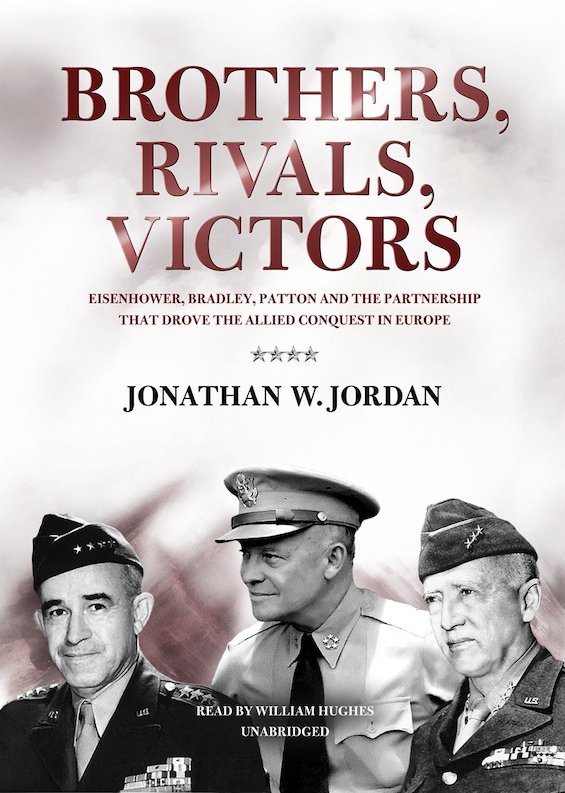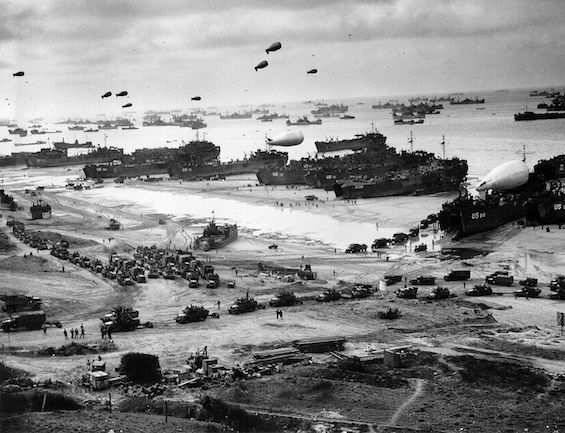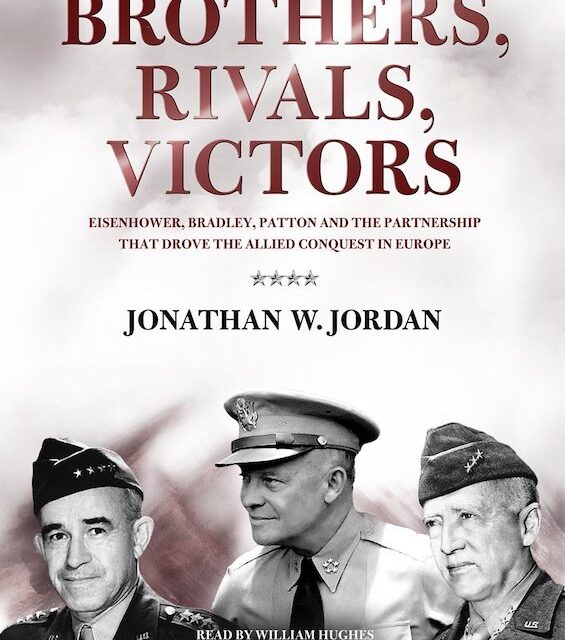
This is the story of three American generals, their on-again, off-again friendship, and the military operations they led from 1942 to 1945 to win the war against Nazi Germany. For those old enough to remember the history, two of their names live on in memory, the third, much less often. But all three played pivotal roles in World War II, and military historians credit them with a large share of responsibility for the Allies’ success in Europe. But when the United States entered the war in December 1941, few at the time would have expected such exalted achievements from any of the three. Dwight D. (Ike) Eisenhower, Omar N. (Brad) Bradley, and George S. Patton rose through the ranks of American officers at a meteoric pace. Historian Jonathan W. Jordan tells their astonishing story in Brothers, Rivals, Victors, and he tells it exceedingly well.
Estimated reading time: 10 minutes
Typical Americans, rich, poor, middle-class
In his introduction, Jordan explains that the book “is a story of a rich man from southern California [Patton], a poor man from the Missouri backwoods [Bradley], and a middle-class man from middle-class Kansas [Eisenhower].” And in telling the tale he makes clear how the values each absorbed in his upbringing expressed themselves in the way these three extraordinary soldiers conducted themselves in the war.
Brothers, Rivals, Victors: Eisenhower, Bradley, Patton and the Partnership That Drove the Allied Conquest in Europe by Jonathan W. Jordan (2011) 674 pages ★★★★★

They reflected the values of their time and place
All three of Jordan’s subjects were born in the closing years of the Gilded Age. Patton, 1885. Eisenhower, 1890. Bradley, 1893. All three were products of West Point and graduated early enough to participate as junior officers in World War I (although only Patton saw combat then). They reflected not just the values of the communities where they were raised but those of their time. Like others in the US military, they were all strongly influenced by the American experience in the Great War, Patton most strongly of all. As junior officers, they languished within the shrinking military establishment throughout the 1920s and 30s, hungering for the combat experience that would enable them to rise in the officer corps.
One dominant theme throughout
If there is a single overarching theme of this book, it’s the ebb and flow of the relationships among these three outstanding men. Jordan quotes extensively from their private diaries and those of others who served with them as well as the official reports, Pentagon histories, and accounts in the press. It is astonishing, even these many decades later, to read how raw and visceral at times was the anger they held for one another in the course of the war. Even more amazing still to think that, despite how much they seemed to hate each other from time to time, they managed to prosecute the war together to a successful conclusion. As Jordan notes, “They could be brilliant and selfless, and they could be shortsighted and petty.”
From 1919 until 1939, Ike and George were close, personal friends. George, who was five years older and outranked Ike, was a mentor of sorts. Brad and Ike had known each other since 1911 but didn’t achieve anything like that level of intimacy until well into the war, when Ike steadily promoted him to a major role in leading American forces on the ground in Europe.
Both men’s friendship with George steadily soured as Patton repeatedly shot off his mouth and alienated his troops with his flamboyant behavior. (The “slapping incident” in Sicily was only the best-known of a great many events that convinced Ike he was a loose cannon. Incidentally, the portrayal of that incident in the film Patton whitewashed the reality, which was immeasurably worse than depicted.) While Ike and George made headlines, Brad was “the tall, quiet man no one would think to take notice of.” Throughout most of the war, he shunned the press.
Their unique skills equipped them well
Ike had the chops to lead in coalition warfare
Jordan skillfully illustrates how the unique skills each of these three men contributed to the Allied victory. Army Chief of Staff George C. Marshall effectively chose Ike as European Theater commander because he had the political and administrative chops to handle the immense pressures of the job. His title was “Supreme Commander,” but that was “criminally misleading.” Ike had to answer to the towering egos of more than a dozen men on the Combined Chiefs of Staff of the US and Great Britain as well as to Roosevelt and Churchill, any of whom could make his life miserable. And he was effectively prohibited from firing several of the key British officers assigned as his subordinates, most notably the vainglorious and stubbornly anti-American Bernard Montgomery.
George was a “fighting general” but no strategist
“Eisenhower was a man whose horizons enveloped politics, industrial policy, planning, and diplomacy, fields as foreign to George as they were immaterial,” Jordan writes. George Patton knew one thing, and he knew it well: how to drive an army at full speed over open territory, destroying every enemy obstacle in his way. He was a tanker, a horse soldier, steeped in the tradition of the cavalry—”by far, the best tank man in the Army,” in Ike’s estimation. George was “one of the most extraordinary fighting generals the Army had ever produced,” his superiors believed. But he was also “the best thespian this side of MacArthur,” with his antics and his loud mouth grabbing headlines and exasperating his superiors.
Brad understood Ike’s strengths but chafed under him
As circumstances made clear, George disdained such essentials of modern, coalition-driven war as logistics, supply, and diplomacy. (As Churchill famously asserted, “The only thing worse than fighting a war with allies is fighting a war without them.”) By contrast, Omar Bradley understood such things perfectly well, and that understanding equipped him to serve as George’s superior on the Continent. He was frequently required to rein in the overeager older man to permit other forces under his command to move ahead in tandem, lest George’s troops be encircled by the enemy or he would outrun his supply lines. But, when Ike was forced to defer to Montgomery and shift troops from Brad’s command to the British, Brad could become as vituperative about him as George ever was.
An alternative view
Some historians question the military strategy pursued by Eisenhower and Bradley and insist that Montgomery and Patton would have won the war more quickly had they been in charge. For Ike and Brad, modern war required the movement of immense numbers of men forward on a broad front to avoid encirclement and eliminate any enemy forces in their way. Montgomery and Patton both emphasized the need for concentrated forces to speed ahead, spearheaded by armor and paratroops, to break through enemy lines.
It certainly is true that Patton demonstrated the wisdom of this approach when he led the American breakout across northern France and, later, into the heart of Germany. But his approach was ineffective in closing up the huge salient created by Nazi troops in the Battle of the Bulge, as it had been in North Africa. And Montgomery’s repeated efforts to concentrate his forces on the Continent proved ineffectual. First, when he was trapped on the coast following the Normandy Invasion, and again when he massed huge armies north of the American lines to drive through the Low Countries into Germany. The latter led only to the disastrous Operation Market Garden. All of which is why I find Jordan’s view of the matter to be persuasive.
When the US entered the war, few expected much of them
When Germany declared war on the US on December 11, 1941, Eisenhower had recently been promoted to brigadier general. He was primarily a staff officer and had never held an active command above a battalion. (He served on Douglas MacArthur‘s staff in the Philippines for much of the 1930s. The two men detested each other.) Months earlier, Ike had held the rank of lieutenant colonel, as he had for many years in the peacetime army.
Both Bradley and Patton had sewn twin stars on their shoulders when the US entered the war—reflecting their promotion to the rank of major general. In the wartime US, generals were, to cadge an expression of the era, “a dime a dozen.” Nearly 1,100 generals served in the United States armed forces during World War II, and more than 7,000 colonels. Ike, Brad, and George were not marked for glory as the country entered the conflict.
The trio’s astonishing rise
Then things changed, as things do in wartime. Eisenhower’s brilliant performance on the staff of the War Department in Washington led to his promotion, first, to major general and then lieutenant general and Commanding General, European Theater of Operations, based in London. In that capacity, he became Patton’s boss, turning the tables on his long-time friend and mentor of two decades. As the war unfolded, Eisenhower received first his fourth star and, in December 1944, his fifth as General of the Army. In “three years, three months, and sixteen days,” Ike rose six levels from lieutenant colonel to five-star general. When the war in Europe drew to a close in May 1945, Brad and George had each gained their fourth star. (Brad would receive his fifth only in 1950.)
Military operations on an immense scale
Many Americans view the Normandy Landings of June 1944 as the biggest event of World War II. It was nothing of the sort. True, the amphibious invasion of France’s northern coast represents to this day the largest such operation in world history. It was, indeed, massive, involving some 6,900 ships, 3,200 aircraft, and 156,000 soldiers from Great Britain, the US, and Canada. But the five divisions that landed on French soil that day paled in comparison to the forces engaged in innumerable other operations conducted throughout the war by both the Allies and the Axis powers.
The biggest military gambit of the Second World War was Operation Barbarossa, Hitler’s invasion of the Soviet Union in June 1941. Some 3.8 million Axis military personnel took part in that ill-conceived adventure, along with 3,500 tanks, more than 3,000 aircraft, 10,000 artillery pieces, and over 600,000 horses. But there were several other operations involving more than one million soldiers. For example, in the Soviet Operation Bagration, nearly 1.7 million personnel killed as many as 450,000 Nazi troops and captured more than 150,000 others, wiping out 28 of 34 divisions of the Germans’ Army Group Centre. Similarly, the 1.3 million American soldiers in the 12th Army Group under Gen. Bradley “bagged 1.86 million enemy troops” in their drive across northern France and deep into the heart of Germany.
About the author

According to his author website, “Jonathan Jordan is a military historian and an award-winning author of three books, including the New York Times bestseller Brothers, Rivals, Victors.” He co-authored a fourth book with his daughter, Emily. Jordan is a regular book critic for The Wall Street Journal, editor of the Library of Texas edition of To the People of Texas, a contributing author to The Amazing Book of World History and The Amazing Book of World War II, and the author of nearly two dozen articles appearing in MHQ: The Quarterly Journal of Military History, World War II Magazine, Military History, and World War II History magazines. Jonathan lives with his family in Marietta, Georgia.
For related reading
For a far less readable but highly detailed account of the key events related in this book, see D-Day: The Battle for Normandy by Antony Beevor (D-Day and Normandy viewed from the ground).
Check out 10 great biographies.
You might also enjoy:
- 10 top nonfiction books about World War II
- Books about World War II in the Pacific
- 7 common misconceptions about World War II
- The 10 most consequential events of World War II
- Top 20 popular books for understanding American history
And you can always find my most popular reviews, and the most recent ones, on the Home Page.



























